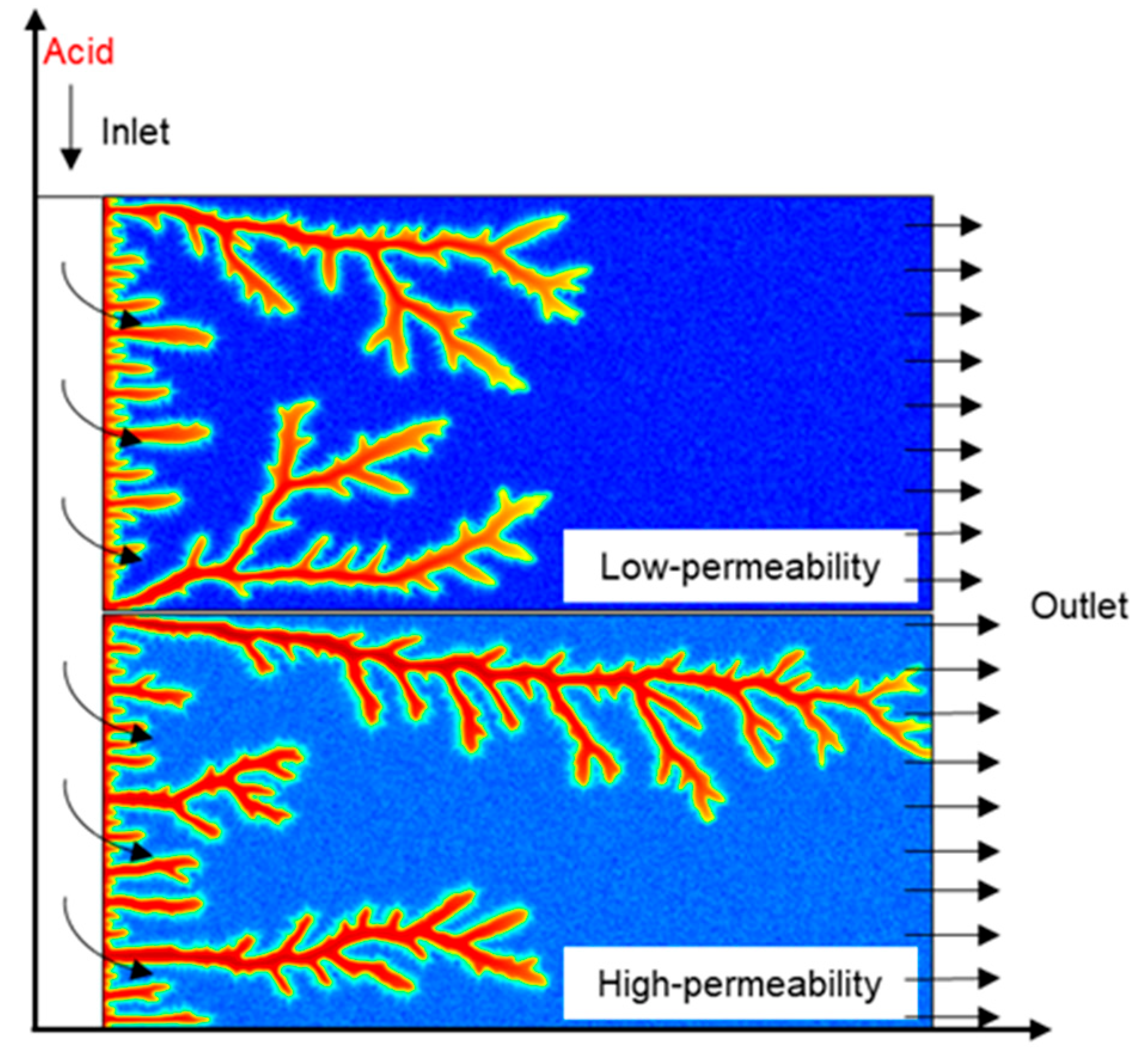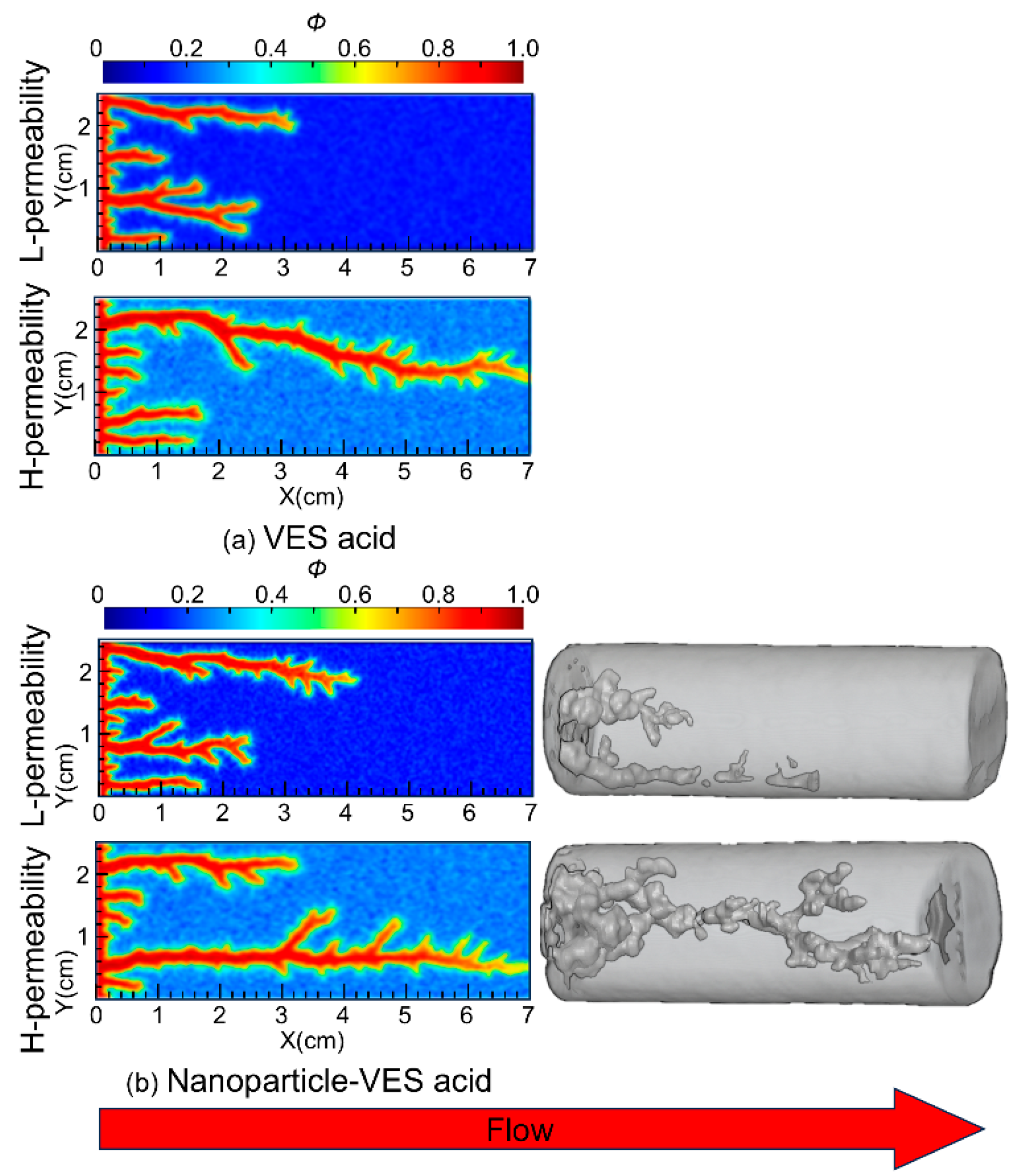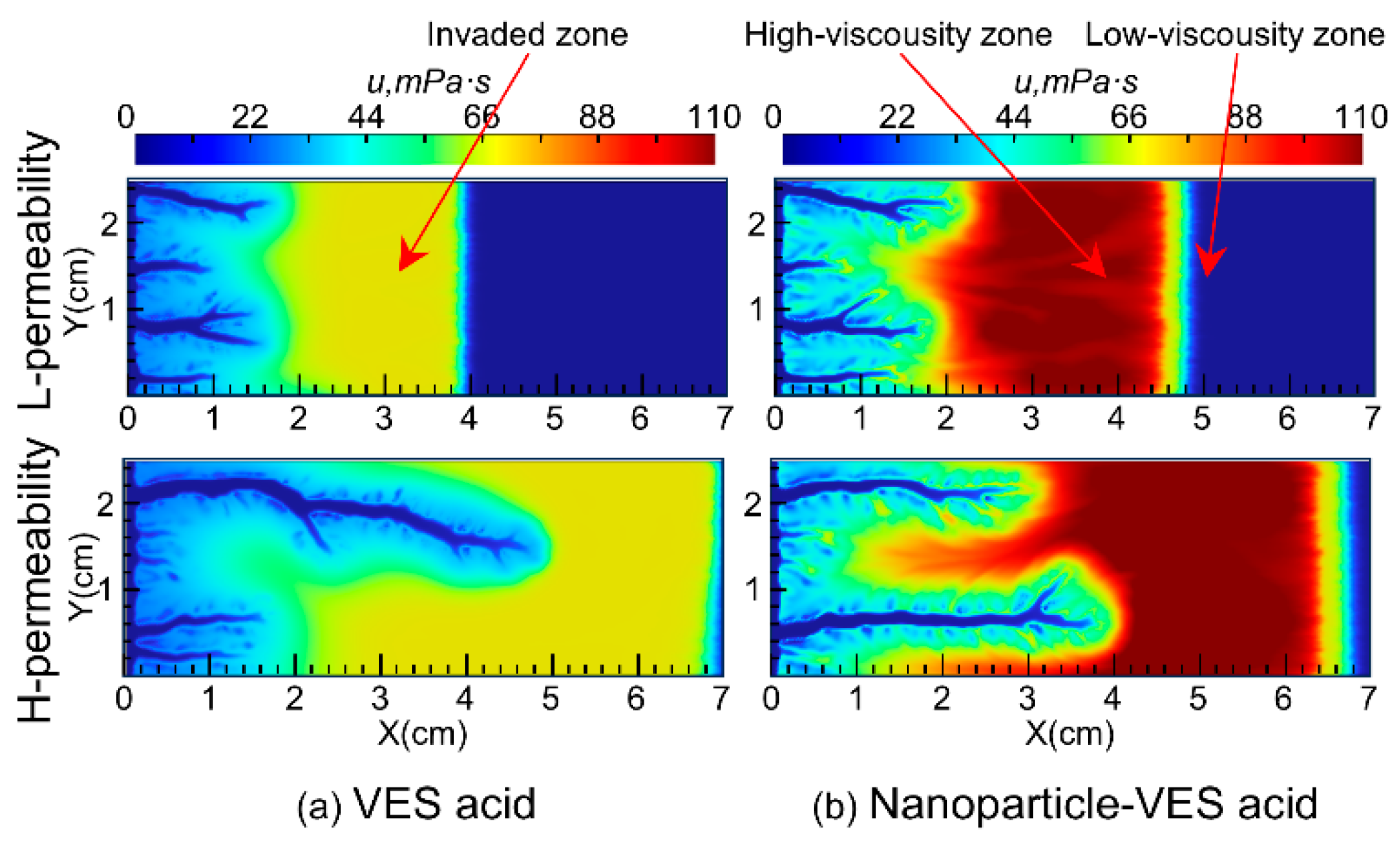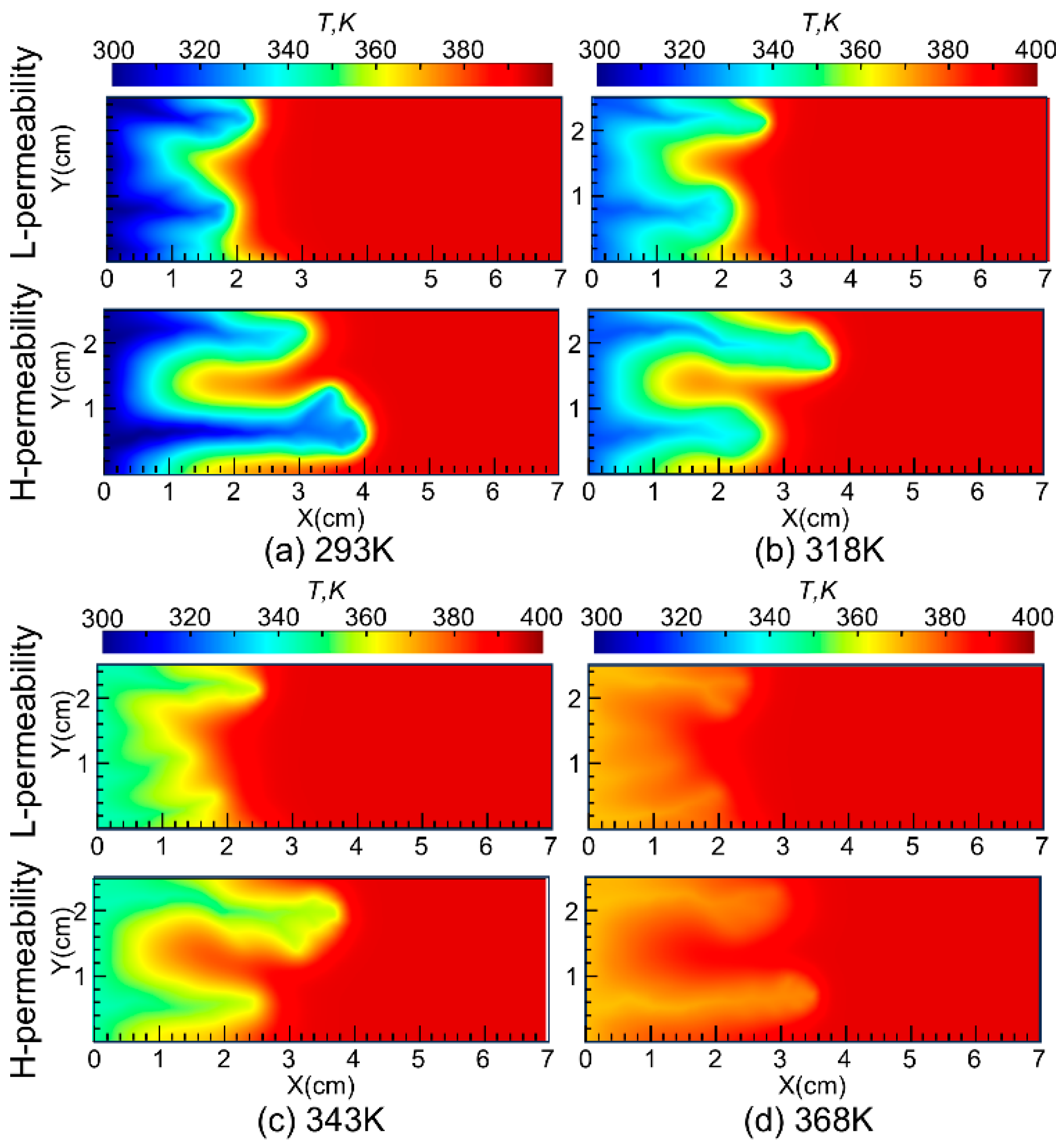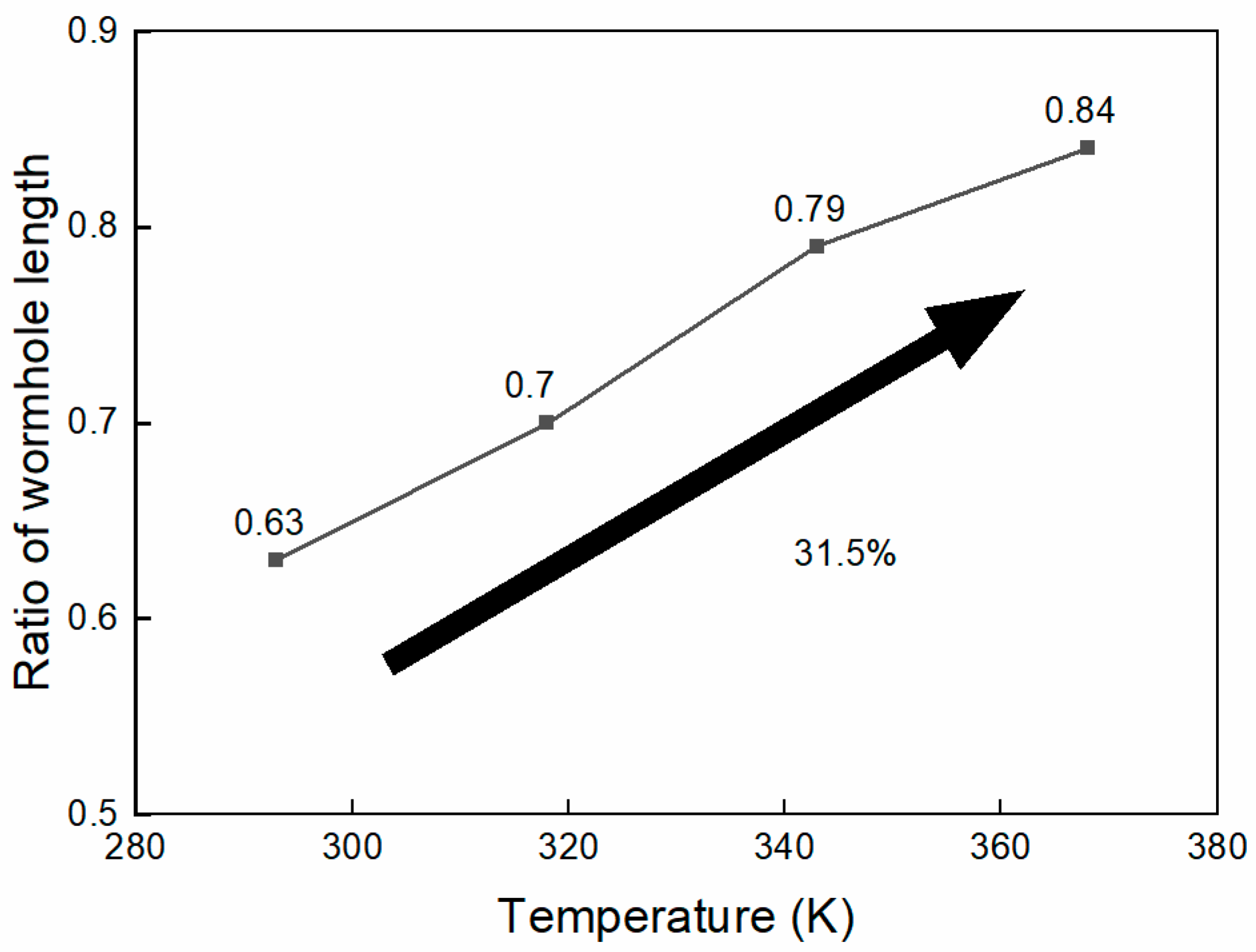1. Introduction
Carbonate reservoirs are a promising reservoir characterized by strong heterogeneity similar to unconventional reservoirs [
1,
2], and uniform acid placement is one of the key technologies for acidizing these reservoirs. The difference between acidizing carbonate reservoirs and sandstone reservoirs lies in the formation of wormholes, which further complicates uniform acid placement. VES acid is a commonly used acid for acid diversion in carbonate reservoirs, but its viscosity decreases rapidly in high-temperature reservoirs. Therefore, improving the diversion ability of VES in high-temperature reservoirs has been a focus of the research in carbonate acidizing.
VES acids commonly use zwitterionic surfactants, such as betaine-type amphoteric surfactants, which exist as individual molecules in fresh acid and are evenly dispersed, resulting in low acid viscosity. As the acid–rock reaction progresses and the pH increases to a certain critical value, the surfactant molecules begin to associate and form micelles. Additionally, divalent metal cations such as Ca2+ and Mg2+, produced during acid–rock reactions, shield the charges between molecules and lead to the adsorption of hydrophilic polar groups, transforming spherical or rigid rod-shaped micelles into worm-like micelles. These micelles then merge to form aggregates with a spatial network structure, significantly increasing the spent acid viscosity in high-permeability layers, thus diverting the acid into low-permeability reservoirs, and this diversion effect continues throughout the acidizing process.
Sibarani and Ziauddin [
3] experimentally researched the influence of rock heterogeneities on acid diversion, finding that high-permeability zones have the largest pore volume breakthrough and the largest relative pressure buildup during VES acid diversion. Molchanov et al. [
4] conducted experiments with a blend of zwitterionic and anionic surfactants, discovering that this combination of VESs could create highly-stable and long-lived worm-like micelles at relatively low concentrations. Zhang et al. [
5] found through numerical simulation studies that foam-based VESs could organically combine the diversion ability of foam and VESs, thereby improving the diversion ability and penetration of wormholes. Wang et al. [
6] developed a new acid–rock reaction model to analyze the competition between limestone and dolomite during carbonate acidizing. The model simulates wormhole propagation and acidizing efficiency, showing that limestone dominates at lower temperatures, while dolomite becomes more influential as the temperature increases. Additionally, the size, density, and orientation of dolomite affect wormhole formation and propagation.
However, VES acid viscosity rapidly decreases under high-temperature conditions. Some studies have been carried out to improve the diversion performance of VESs, including introducing metal salts, auxiliary surfactants, polymers, and nanoparticles. Nanoparticles, due to their large surface area, can adsorb VES molecules onto the nanoparticles, acting as “cross-linking agents” that extend VES micelles and increase the complexity of their network structure, thereby improving viscosity and enhancing the temperature resistance ability of VES [
7]. Hanafy et al. [
8] found that nanoparticles at relatively low concentrations can improve the thermal stability and viscosity of cationic VESs, and the shape of nanoparticles has a significant impact on the viscosity of VESs. Philippova et al. [
9] demonstrated that the addition of nanoparticles to VES fracturing fluids significantly improves the thermal stability and viscoelasticity of VESs. By altering the surface characteristics of nanoparticles, the sand-carrying ability of nanoparticle-based VES fracturing fluids can also be effectively enhanced. A literature review shows that related studies mainly focus on nanoparticle VES fracturing fluids, with little research on nanoparticle VES acid. The lower pH and higher Ca
2+ concentration of VES acids significantly affect the adsorption performance of nanoparticles, thereby influencing the expansion and diversion performance of nanoparticle VES acid in wormholes. This necessitates further experimental and numerical studies.
This paper first establishes a rheological model for nanoparticle VES acid based on the rheological characteristics of nanoparticle VES acid at different temperatures and nanoparticle concentrations. Then, a multi-scale, multi-field coupled model of nanoparticle VES is established by coupling the two-scale continuum model, temperature field and adsorption model. The accuracy of this nanoparticle VES acid model is verified through laboratory core flooding experiments. A comparative analysis of the diversion mechanism of nanoparticle VES acid is conducted, and the effects of permeability contrast and temperature on wormhole propagation and diversion performance are studied.
2. Model Description
The two-scale continuum model is the most commonly used model for simulating the propagation of wormholes during acidizing in heterogeneous carbonate formations. This model, first proposed by Panga et al. [
10,
11], has been developed by several researchers and can accurately describe the propagation of wormholes and the diversion of acid fluids. In this paper, temperature field, nanoparticle adsorption model, and nanoparticle VES acid rheology model are introduced and coupled with this model to study the wormhole propagation and diversion effect of nanoparticle VES acid. When establishing the model, the effects of source sink terms, inertial forces, gravity, and the compressibility of fluids and rocks were neglected.
2.1. Darcy-Scale Model
The two-scale continuum model considers the flow of acid fluid and establishes dynamic boundary conditions to calculate the dissolution of heterogeneous carbonate rocks at each time step, thus obtaining the propagation of wormholes.
At any given reaction moment, the Darcy-scale model uses the continuity equation and the more flexible Darcy–Brinkman equation to describe the micro- and macro-flows of acid fluid in the pore matrix and wormholes:
The reaction of nanoparticle VES acid with carbonate rock causes the concentration of substances in the acid fluid to decrease gradually as the fluid moves. By establishing a reaction equation for nanoparticle VES acid, the distribution of H
+ ions in the acid fluid can be obtained. The distribution of surfactant concentration and the impact of Ca
2+, generated in the acid–rock reaction, on the viscosity of the acid fluid are also significant. The following equations for H
+, Ca
2+, and VES concentrations can be derived from the reaction equilibrium principle:
2.2. Pore-Scale Model
The acid fluid dissolution will inevitably change the pore structure and thus affect the related reservoir physical parameters. However, quantitatively characterizing the relationship between these parameters and pore structure is challenging. The two-scale continuum model uses the semi-empirical Garman–Kozeny formula to describe the relationship between porosity, permeability, specific surface area, and changes in pore structure [
12]:
The mass transfer rate of the acid solution and the solid–liquid surface reaction rate are two decisive parameters that affect the acid–rock reaction rate. The mass transfer coefficient of the acid solution is characterized by the Sherwood number [
13,
14].
The diffusion coefficient is the diffusion rate of reactive ions:
2.3. Temperature Field of Porous Medium
The development of wormholes in carbonate reservoirs is not only related to acid–rock reactions and mass transfer but also to temperature [
15,
16]. The higher the temperature, the faster the diffusion rate of H
+ and the reaction rate with carbonate rocks. The diffusion coefficient and acid–rock reaction rate constant can be expressed by the Arrhenius equation [
17], and the values of the relevant parameters are shown in
Table 1:
The effect of temperature on acid etching wormhole formation mainly comes from two aspects: the heat released by the acid–rock reaction and the cooling effect of the relatively low-temperature acid solution on the reservoir rock. Among these, the impact of heat released by the acid–rock reaction on the temperature field is small, so this study does not consider the influence of the heat released by the acid–rock reaction on the reaction temperature field. The heat transfer equation for the flow of acid solution in the pore spaces of the reservoir rock is as follows:
2.4. Nanoparticle Adsorption
Silica nanoparticles are transported with the flow of acid into the reservoir porous medium, and this process satisfies the mass conservation equation. Due to their unique physicochemical properties, especially their large specific surface area, nanoparticles can adsorb to pore surfaces through hydrogen bonding and van der Waals forces [
19,
20]. Experimental studies have shown that nanoparticle adsorption in porous media follows the Langmuir adsorption theory [
21]. The transportation behavior of nanoparticles in porous media can be described by the following equation:
2.5. Rheological Characteristics of Nanoparticle VES Acid
The viscosity of fresh VES acid is low, but after reacting with the carbonate reservoir, the pH of the acid fluid rises, causing VES to aggregate into spherical micelles. At the same time, H+ reacts with the carbonate rock minerals, generating divalent cations like Ca2+ that further drive the spherical micelles to form rigid rod-like micelles, creating a network structure that significantly increases the viscosity of the spent acid.
Mou et al. [
22] developed a rheological model for the VES acid system considering VES concentration, pH, Ca
2+ concentration, and shear rate:
During the flow of the acid in the reservoir, heat exchange occurs between the reservoir rock and the acid solution, leading to an increase in the temperature of the acid solution. Temperature has an important impact on the rheological properties of the acid solution. The viscosity of the VES used in this study increases with temperature. Through laboratory experiments, the relationship between VES acid and temperature is obtained as follows:
According to experimental results, it is found that nanoparticles can effectively increase the viscosity of the spent VES acid. By fitting the rheological experimental data, the relationship between the viscosity of nanoparticle VES acid and nanoparticle concentration can be expressed as follows:
2.6. Model Structure, Initial and Boundary Conditions
The nanoparticle VES acid model structure and flow pattern are illustrated in
Figure 1. Similar to core flow experiments, this model divides the core into an upper low-permeability and lower high-permeability core.
The acid fluid is injected at a constant flow rate
q0, and the exit pressure is set at a constant
Pe, while the other boundaries are closed. The continuously injected acid solution almost simultaneously contacts both the high-permeability and low-permeability rock surfaces and enters into the core under the pressure difference. The flow resistance of the high-permeability core is lower, so more acid flows into the high-permeability core, resulting in an imbalance in the amount of acid entering into the high-permeability core and low-permeability core. The acid solution formulation is 20 wt% HCl + 5 wt% VES + 0.05 wt% nanoparticles, with the concentrations of the acid, nanoparticles, and VES maintained constant throughout the injection process. Initially, the pressure inside the system is
Pe, and the flow velocity is zero. The main boundary conditions involved in the model are as follows:
The model is solved using Python 3.12 with the finite element method, and the required parameters for the calculations are shown in
Table 2. The calculation ideas and processes of the model in this paper are shown in
Figure 2.
3. Result and Discussion
3.1. Wormhole Propagation Pattern
VES acid behaves differently from conventional acid in that, after entering the high-permeability region, the spent acid forms worm-like micelles under the influence of increasing pH and Ca2+, which increases the viscosity of the spent acid and causes subsequent acid fluid to be diverted into the low-permeability zone. Nanoparticle VES acid can further enhance the diversion capability of the acid fluid. This paper compares the behaviors of VES acid and nanoparticle VES acid through laboratory experiments and numerical simulations.
Core flow experiments used 7 cm-long Indiana limestone cores, with permeabilities of approximately 5.3 mD and 40.8 mD (permeability contrast = 8). The acid solution formulation consisted of 20% HCl, 5% VES, 0.05% nanoparticles, and 1% corrosion inhibitor. The SiO
2 nanoparticles (15 nm) were purchased from Jiangsu Qiuyi New Material Company, VES-120 was synthesized by research team, and the anhydrous calcium chloride was purchased from Shanghai McLean Biochemical Technology Co. The back pressure of the core flow system was at 7 MPa to increase system pressure. The parallel core flow experiments were conducted at a temperature of 363 K. The experimental procedures are the same as those in a paper published by Zhang et al. [
23]. The experimental results are shown in
Figure 3. The results indicated that the penetration depth of nanoparticle VES acid in the low-permeability core was 4.51 cm.
Numerical simulations used cores with the same permeability contrast of 8, with permeabilities of 5 mD and 40 mD. The reservoir temperature was set to 393 K, and the acid solution temperature was 298 K. The simulation results are shown in
Figure 3. From the simulation results, it can be seen that in the low-permeability core, the wormhole penetration depth of nanoparticle VES acid is 4.40 cm, compared to 3.28 cm for VES acid. The ratio of wormhole development length in low-permeability to high-permeability cores for both types of VES acid increased from 46.9% to 63.1%, meaning that the wormhole penetration ability of nanoparticle VES acid in low-permeability reservoirs is 16.2% greater than that of conventional VES acid, which is in good agreement with the laboratory experiment results. Both the experimental and simulation results indicate that nanoparticle VES acid can effectively improve the penetration depth of acid etching wormholes in low-permeability zones and improve the effect of uniform acid distribution, thereby helping to solve the problem of the poor stimulation effects of VES acid in low-permeability reservoirs at high temperatures.
Figure 4 shows the distribution of Ca
2+, VES molecules, and nanoparticles during the acidizing process for both VES acid and nanoparticle VES acid. The simulation results indicate that the Ca
2+ produced by the acid–rock reaction of VES acid and nanoparticle VES acid is continuously pushed deeper into the core by the injected acid, resulting in higher concentrations in the deeper parts of the core compared to the injection end. As the VES molecules in the acid solution moves, it undergoes a transformation from spherical micelles to rod-shaped micelles under the influence of Ca
2+ and pH, forming a spatial network structure. This significantly increases the viscosity of the spent acid and enables the acid diversion.
The viscosity of the VES system used in this study increases with increasing temperature in the 150 °C VES rheology test. Because the VES spent acid is continuously heated by the reservoir during its flow from the wormhole into the porous medium, its viscosity gradually increases (
Figure 5a). In carbonate reservoirs, there is a wormhole zone and a spent-acid-invaded zone during acidizing (
Figure 6a). Compared to conventional HCl acid, the spent acid in the VES acid-invaded zone has higher viscosity and greater flow resistance, enabling acid diversion. Numerical simulation of nanoparticle VES acid shows that the concentration of nanoparticles in the acid solution gradually decreases due to adsorption in the porous medium, resulting in a region where only VES spent acid is present without nanoparticles (
Figure 4c). In this region, the viscosity of the spent acid is also significantly lower than in areas with nanoparticles (
Figure 5b). Therefore, from the comparison of VES acid and nanoparticle VES acid numerical simulation results, it can be seen that, unlike VES acid, the invaded zone of nanoparticle VES acid is subdivided into a high-viscosity zone with nanoparticles and a low-viscosity zone without nanoparticles in the invaded zone (
Figure 6b). In the high-viscosity zone, nanoparticle VES acid has higher viscosity than VES acid, while in the low-viscosity zone, after nanoparticles are adsorbed by the formation, the viscosity of nanoparticle VES acid becomes the same as that of conventional VES.
3.2. Permeability Contrast
Permeability contrast is a key indicator for evaluating the heterogeneity of the reservoir and the diversion performance of the acid. The permeability contrast for conventional VES acid in carbonate reservoirs is around 10 [
24]. To verify the diversion performance of nanoparticle VES acid, simulations were conducted to study the wormhole propagation in 7 cm-long carbonate cores with permeability contrasts of 5, 8, 10, and 12. The simulation results are shown in
Figure 7. The numerical simulation results indicated that as the permeability contrast increased, the length of the wormhole in the low-permeability core gradually decreased.
The ratios of the wormhole length in the low-permeability core to the high-permeability core under the four contrast conditions were 0.82, 0.63, 0.53, and 0.29, as shown in
Figure 8. The simulation results suggest that when the permeability contrast of the core is less than 10, nanoparticle VES acid performs well in low-permeability cores. However, when the permeability contrast exceeds 10, the wormhole in the low-permeability core cannot effectively penetrate the damaged zone of the low-permeability core.
The simulation results indicate that nanoparticle VES acid exhibits excellent diversion performance, which is the result of two factors. First, unlike conventional VES systems, the high-temperature-resistant VES system exhibits an increase in viscosity with rising temperature, allowing the system to maintain a high viscosity even under high-temperature conditions, thereby adapting better to high-temperature environments. As the temperature increases, the viscoelasticity of this system increases, effectively resisting the flow resistance in reservoirs with large permeability contrasts, thereby facilitating better penetration and expansion of the acid into lower permeability zones.
Additionally, one of the key characteristics of nanoparticle VES acid is that the surface properties of the nanoparticles in the acidic environment promote more effective self-assembly of surfactant molecules in the acid solution, forming viscoelastic micelles and a spatial network structure. This significantly enhances the fluid’s diversion ability, forming high-viscosity regions, which greatly improves the fluid’s diversion capability.
3.3. Temperature Effects
This section investigates the impact of injected acid temperature on wormhole propagation and acid diversion performance, given the unique rheological characteristics of this VES system. The rheological experimental results of the VES system show that its apparent viscosity increases with temperature, making the acid system suitable for matrix acidizing in high-temperature reservoirs. When low-temperature acid is injected into the reservoir, it cools the rock in the wormhole region, which may cause the spent acid viscosity in this region to be lower than that in the deeper regions. However, temperature not only has a significant effect on the apparent viscosity of this acid system but also directly influences the acid–rock reaction rate. Therefore, the impact of temperature on the wormhole propagation and acid diversion performance of nanoparticle VES acid is a complex, multi-factor problem that requires further study.
The distribution of viscosity during wormhole propagation under different injected acid temperatures is shown in
Figure 9. The simulation results indicate that, under different injection temperatures, the viscosity of the acid in the wormhole region is lower than in the surrounding external regions. After the nanoparticles are completely adsorbed by the reservoir, the viscosity of the acid decreases further. The reason for the lower viscosity in the wormhole region compared to the adjacent regions is due to the lower Ca
2+ concentration carried by the acid solution, as well as the higher H
+ concentration in the wormhole region, which prevents the VES acid from reaching the critical pH value necessary for thickening.
Additionally, it is related to the unique rheological properties of the VES acid system, which is greatly influenced by temperature. As shown in
Figure 10, nanoparticle VES acid at higher injection temperatures results in higher temperatures in the wormhole and surrounding regions. Coupled with the rheological characteristics of the system, the higher temperature increases the viscosity of the spent acid, thereby enhancing its diversion capability.
To further investigate the impact of temperature on the diversion performance of nanoparticle VES acid, simulations were conducted at injected acid temperatures of 293 K, 318 K, 343 K, and 368 K. The propagation of wormholes in core samples with a permeability contrast of 8 was simulated, and the results are shown in
Figure 11. The simulation results indicate that, within the temperature range of 293 K to 368 K, as the injected acid temperature increases, the wormhole lengths in low-permeability cores gradually increase, suggesting that higher injected acid temperatures are beneficial for the diversion performance of the nanoparticle VES system. Additionally, the simulation results show that the acid-etched wormholes in high-permeability cores are more branched compared to those in low-permeability cores. This is because the acid fluid flows faster in high-permeability cores, allowing it to penetrate a larger area of the porous medium, thus forming more branched wormholes. This is consistent with the results of previous research that the injection rate significantly affects the morphology of wormholes, and wormholes gradually transform from face dissolution to conical wormholes, dominant wormholes, ramified wormholes, and uniform dissolution as the injection rate increases [
25].
The ratio of wormhole lengths in high- and low-permeability cores at different injected acid temperatures is shown in
Figure 12. As the injected acid temperature increases, the wormhole length in low-permeability cores gradually increases. When the injected acid temperature is 293K, the wormhole length ratio between low-permeability and high-permeability cores is 0.63. When the injected acid temperature is raised to 368K, this ratio reaches 0.84, indicating that the wormhole penetration capacity in low-permeability reservoirs has increased by 33.3%. This suggests that increasing the injected acid temperature helps to enhance the diversion effect of the system.
